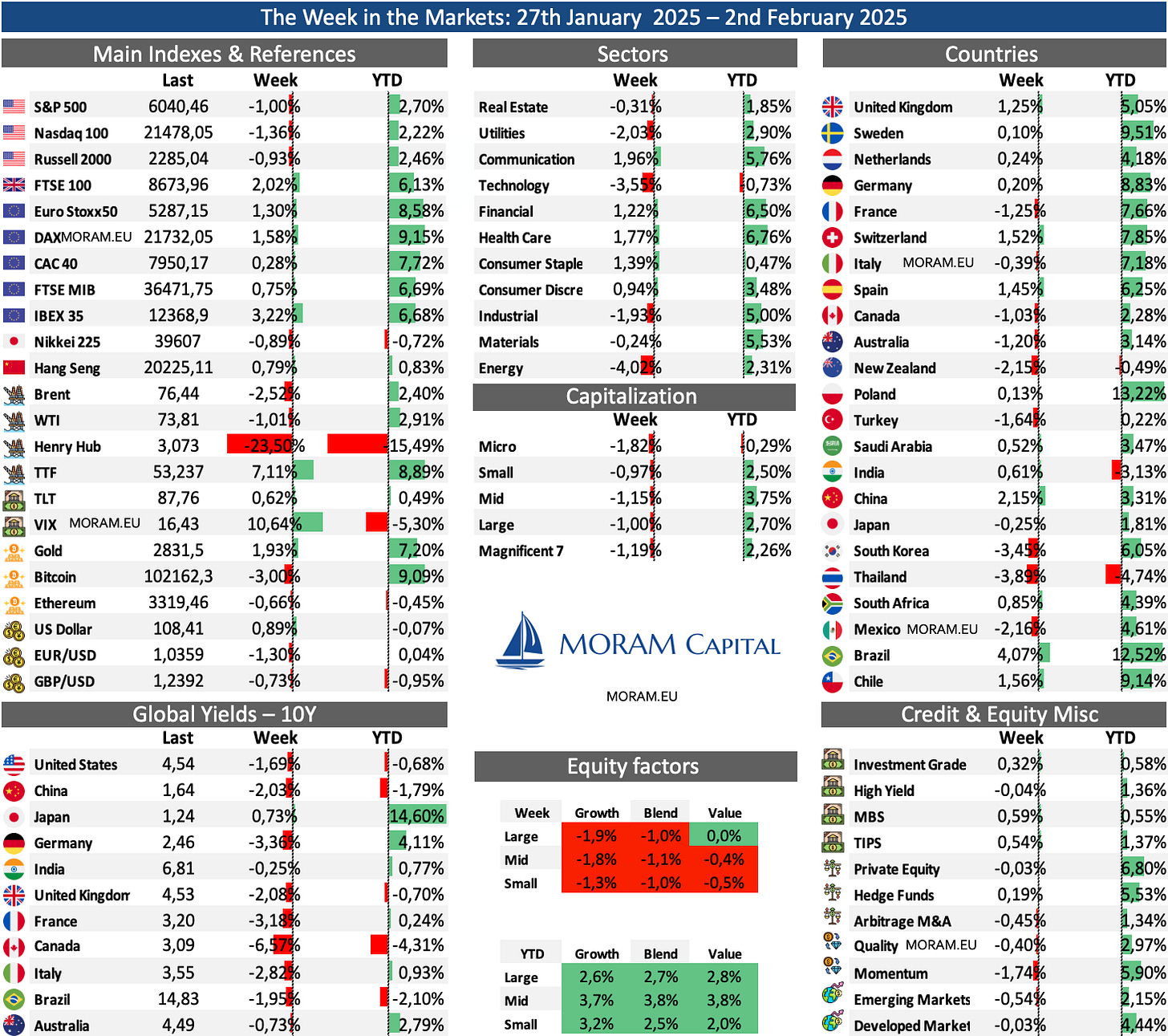Hi there, we hope you had a fantastic week !
Please find this brief summary of the topics we are covering today
The Week in the Markets
Our weekly summary with the best charts to understand what happened in the markets in 1 minute, along with explanations for those who want to dive deeper.
Equities, Bonds, Currencies, Alternative Assets, Macro Data, company commentaries, Earnings Season, and much more!
Equity Research
Guide to the Beverage Industry - After several months analyzing companies in different parts of the value chain (beverage producers, glass manufacturers, barrels,…), we are sharing this guide where we explain how the industry works (not all parts recover equally), present our preselected companies that are worth considering, explain them, and explore different ways to play the industry's recovery.
To achieve this, we brought on our team an expert in the sector months ago. Honestly, we believe there is nothing similar on the internet covering the entire industry
Special Update: New Fortress Energy - Earlier today we shared our updated analysis of New Fortress Energy, a company we have been covering for the last 5 years. After almost lifting the company to the skies due to the high debt a few months ago, the momentum seems to be changing with the excess production of its Fast LNG, the high TTF prices, and the developments in PR, Brazil, and Jamaica. But it’s not all good news. We analyzed the current situation and updated our valuation and target price
Portfolio Management
Including updates on our 3-stage monitor, comments on several companies, and our macro views, along with their respective movements in both equities and all asset portfolios
Investor Resources
Data Center Update
Financial model Updates
Nota: Toda esta publicación está disponible en Español en nuestra web
The Week in the Markets
Summary
A week to remember, where the final numbers likely don’t fully reflect everything that has happened. On Monday, it seemed like the world was ending due to the threat triggered by Chinese AI startup DeepSeek, whose open-source AI model rivals leading U.S. firms at a lower cost and with less computing power, raising concerns about overspending in the U.S. AI sector. However, these declines were recovered throughout the week, as, in the end, this means greater competition and lower costs, which will likely boost AI adoption, driving further investment in the industry.
The main consequence was significantly greater breadth in the indices (meaning the Mag7 underperformed compared to small and mid-cap companies). In fact, January ended with the S&P 500 equal weight up +3.43%, outperforming the S&P 500.
Europe continues to widen the gap against the U.S. stock market at the start of the year (long overdue after the last 15 years), while in Asia, January passed without much impact.
At the industry level, tech has been the worst performer this week (mainly due to Nvidia's -14% drop, as you can see in the detailed one-pagers later in this publication), along with declines in energy (driven by oil and a Henry Hub that has fallen -23%—details on the European TTF later).
A key highlight is gold reaching all-time highs, surpassing $2,800/oz, and the strength of the dollar (detailed in the new currencies one-pager, where the Brazilian Real stands out due to its recovery following the latest rate hike).
Macro highlights
The highlights of the week were the central bank meetings in the United States and Europe, where their decisions diverged. Additionally, the PCE data and Q4 GDP figures were released in the US.
FED - United States (Meeting Summary)
The Federal Reserve decided to keep interest rates unchanged at 4.5% and continue balance sheet reduction without modifications.
Interest Rate Policy: There is no rush to adjust rates, as decisions will remain data-driven. Inflation and labor market conditions will be key factors before any further cuts. The Fed emphasized that it is not necessary to wait for inflation to reach 2% to continue lowering rates.
Inflation: Long-term inflation expectations remain well-anchored. Although inflation is still high, there are no immediate signs of action. Housing inflation is expected to decline steadily.
Employment: The labor market is not generating inflationary pressures. Foreign labor inflows have decreased, stabilizing the unemployment rate.
Long-Term Interest Rates & Financial Markets: The rise in long-term interest rates is attributed to the term premium rather than concerns about politics or inflation.
Economy & Markets: The PCE inflation index rose above 2% in 2024, but asset prices remain high due to economic resilience.
In conclusion, the Fed is maintaining a cautious, data-driven approach, avoiding premature rate cuts while monitoring inflation and employment trends.
US PCE Data
The December PCE inflation increased by 0.26% from November, higher than the 0.13% rise in the previous month but slightly below the expected 0.27% based on CPI and PPI. However, this marks the largest increase in eight months, pushing the annual rate up to 2.6% from 2.4%.
The core PCE index (excluding food and energy) rose by 0.16%, slightly above November’s 0.11% but below the 0.18% forecast. Over the past 12 months, core prices have increased by 2.8%.
Goods prices rose 0.2% after being flat in November.
Services prices increased 0.3%, up from 0.2% in the prior month.
US GDP 4Q
The U.S. economy grew at an annualized rate of 2.25% (rounded to 2.3%) in Q4 2024, marking the slowest growth in three quarters. This was below the 3.1% growth in Q3 and the 2.6% forecast, though the Atlanta Fed had already predicted a slowdown.
Breakdown by components:
Personal spending was the main driver, contributing 2.82%, more than 100% of total GDP growth.
Fixed investment subtracted -0.1% from GDP.
Private inventory changes reduced GDP by -0.93%.
Net trade (exports minus imports) had a neutral impact (-0.04%), improving from Q3’s -0.43% drag.
Government spending added 0.42% to GDP, continuing a 10-quarter streak where federal debt directly boosted U.S. growth.
ECB - Europe
The ECB reduced its key deposit rate by a quarter of a percentage point to 2.75%. If it weren't for the pattern set by the FED, it would be clear that they are likely to continue with rate cuts (this is the 4th consecutive cut) in the upcoming meetings due to the weaknesses in macro indicators across Europe. However, they cannot afford such a large policy divergence with the US, and the market is forecasting a 70 basis point cut this year, meaning 3 more cuts in 2025.
On the other hand, the eurozone stagnated in Q4 2024, missing the 0.1% growth forecast, but full-year growth (0.7%) matched ECB projections. Germany and France contracted, Italy remained flat, and Spain grew by 0.8%. January inflation figures were as follows: France at 1.8%, Germany at 2.8%, and Spain at 2.9%.
Interesting Data about markets this week & YTD
Brazil’s central bank decided to raise its key interest rate, the Selic rate, by 100 basis points, from 12.25% to 13.25% and another similar is expected in March
Inventories in Europe are already at 54%, in addition to a winter colder than previous ones, The gas situation in Ukraine is critical with gas inventories at only 11% capacity (with February and March still left of the cold).
We close the month of January, and unlike what we've been used to in the past two years, the Mag7 have underperformed the rest of the companies. The S&P 500 equal weight has risen 3.43%, outperforming the S&P 500’s 2.62%.
Earning Season 1Q25
We are in the most important period of earnings season. This week, which is ending today, 4 of the 7 Magnificent companies reported, with Apple, Microsoft, and Meta outperforming expectations in both revenue and earnings per share, while Tesla fell short on both fronts. However, Tesla’s stock still rose, driven by optimism around supportive regulations and the upcoming budget-friendly models.
For the quarter, S&P 500 earnings are projected to climb 12%, marking the fastest growth since 2021 if realized. Gains are expected across industries, with seven out of 11 sectors anticipating higher earnings. This strong momentum is forecasted to extend into 2025, with analysts predicting 14%+ earnings growth.
For next week, Spotify, Alphabet, PayPal, Pfizer, Uber, Lilly, and Amazon stand out. Additionally, within the companies in our universe, we will pay special attention to Good Times Restaurants and the remaining US boat manufacturers. (We have no exposure to this industry, but now that it seems to be at the lower end of its cycle, we want to incorporate it into our yacht vertical. The economics of both are completely different, as we have mentioned many times, but it likely makes sense to cover both industries under the same umbrella.)
Guide to the Beverage Industry
Introduction
Recently, we decided to expand our coverage of the beverage industry beyond the companies that we have analysed in depth in the past (Italian Wine Brands, Duckhorn Portfolio and TFF) mainly due to the tremendous declines the sector has experienced in the last two years and the quality of most of the companies that make it up (we’re not just talking about beverage providers, probably the most well-known companies, but also companies across the entire cycle such as those making glass bottles, barrels for wine and whisky, corks...). To address this, a few months ago we brought Iñigo onto the team, a person with immense industry knowledge who is helping us develop this vertical so we can start monetising it soon (it’s a very cyclical industry)
Until 2 years ago, the beverage industry was considered a great business to be in. One could repeatedly hear that the leading alcoholic beverage producers in both spirits (Diageo, Pernod, Campari, Brown-Froman and Remy) and beer (Anheuser, Heineken, Constellation Brands and Carlsberg) categories had a strong moat thanks to their strong brand, loyal customers and ability to raise prices without losing customers.
Two years later, after a huge drawdown since January 2023 as we can observe in the following image their business fundamentals are being questioned by the market.
The alcoholic beverage company suppliers have also had historically a good standing among value investors. Some might argue that their businesses are even superior than those of the beverage producers. In the decade from January 2014 to January 2024, the investment in all Vidrala, Corticeira and TFF produced brilliant returns of around 15% CAGR. Similar to the beverage producers, most of these suppliers are trading at 5-year lows.
We believe that all the companies operating in this industry (including suppliers) are suffering the impacts of a temporary supply chain disruption that is greatly impacting both their sales and their operating margins. The speed of recovery for this companies will not be the same for each one of them, it will depend on their product categories, specifics of their operation and the company-specific dynamics.
In today’s analysis, we focus on:
Introduction to the Beverage industry and the current state of the industry, (issues in the supply chain, lower demand from young people…)
Explanation of how each sub-industry within the industry works, the differences in their respective cycles, and the current trends in each.
The expected recovery from the cycle-low most of these companies are experiencing.
The specifics of the operations of each of the segments in the beverage industry.
The difference in their financials (and how to analyse each subindustry)
Analysis of the mid/small-cap companies that we have studied, and our selection of the companies we find most attractive in each sub-industry
We believe this is one of the most comprehensive analyses of this industry, which not only focuses on the well-known alcoholic beverage providers but on the entire industry—identifying very interesting opportunities while discarding others that may seem attractive at first glance but still have a long way to recover.












